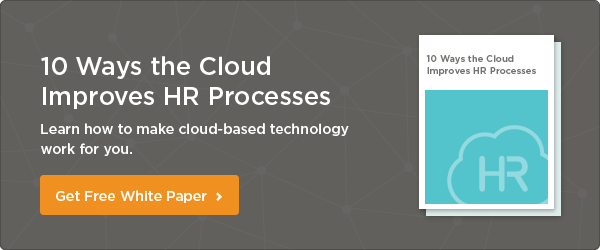

 Cut onboarding time
by 60%—here's the
Ultimate Checklist
that helped do it.
Cut onboarding time
by 60%—here's the
Ultimate Checklist
that helped do it.

When contemplating the onboarding process for new employees, it’s common to think the responsibility resides solely in the domain of the HR department.In many organizations, for many years, companies have held new employee orientation—a day when new hires drink coffee and eat donuts, sign up for benefits, and affix their signature to mounds and mounds of paperwork. The day is considered complete when the new employee attests, in writing, that they have watched the latest iteration of the “Workplace Harassment Training Video” (production date circa 2002) before being unleashed into the organization.
But onboarding is something different, and it’s not an event. The onboarding process is an experience.
Talya N. Bauer, PhD, describes onboarding as “the process of helping new hires adjust to social and performance aspects of their jobs quickly and smoothly.” —A perfect definition.
Dr. Bauer goes on to divide onboarding into four distinct parts which she calls “The Four C’s”:
• Compliance – Teaching employees basic legal and policy-related rules and regulations.
• Clarification – Ensuring new employees understand their new jobs and all related expectations.
• Culture – Providing employees with a sense of organizational norms—both formal and informal.
• Connection – Helping the new employee establish vital interpersonal relationships and information networks.
When we dive into these four areas, it becomes fairly apparent that ensuring new hires successfully adjust requires the input of more than just the HR staff. It does, indeed,take a village.
The Role of HR
While the bulk of the compliance related aspects continue to sit in HR’s wheelhouse, the human resources department should not merely focus on completing checklists, disseminating policies, and making sure I-9s and W-4s are completed accurately. As I discussed recently, the onboarding process neither starts nor ends on the date of hire; it begins at the moment the candidate accepts the job offer and continues on well past the employee’s first day of employment.
HR staff members can use this time between accepted offer and start date to not only clarify this new and exciting career opportunity, but also reinforce unique attributes of their company culture. Message, style, tone, and format of communication in this critical period will ensure the transition is smooth, seamless, and appealing for the newly hired employee. It’s also at this stage when HR representatives can kick off the socialization process. They can, for example, provide access to cloud-based technology used by staff so the new hire can begin to ‘meet,’ learn from, and talk to future coworkers.
The Role of the Manager
An employee’s direct supervisor plays a critical role in making sure the new hire has clarity around job role and performance expectations. While these things were discussed during the interview and selection process, when an employee joins the team, it’s time for the manager to align the employee’s individual objectives with organizational strategy, set goals, and pave the way for success. While managers may use onboarding technology to assist in the process, it’s not the only tool in their toolbox—one-on-one conversations, immediate and regular feedback, and ongoing clarification regarding expectations and progress are necessary.
The Role of Coworkers
In organizations where relationship building is encouraged, there are greater opportunities to positively influence the new employee’s adjustment. This is easily accomplished by ensuring that employees have the opportunity to develop social relationships with coworkers and team members. This doesn’t mean just saying to the new hire, “You can get to know Janice because she sits in the cubicle next to you.” Instead,the focus should be on empowering and encouraging employees to connect with each other across boundaries, department silos, and functions.
Coworkers should be applauded (and recognized) when they meet with new employees, whether as a formal sit-down or merely grabbing a casual cup of coffee in the company cafeteria. The current employee can share input about their own position, explain how their role will interact with the new hire’s role, and how they anticipate collaborating with the new employee in the future. Coworkers, whether in the same department or another part of the company, can also serve as peer mentors and ‘company connectors’ where they serve as a resource for questions and information. This can be a great way to provide new hires with a realistic understanding of company culture and expected behaviors.
The Role of Organizational Leaders
Organizational leaders are busy guys and gals. Depending upon the size and scope of the organization, it may not be feasible for the CEO, CFO, or CMO to meet, greet, and get to know every new employee. It’s still important, however, that they participate in the onboarding process at various touch points.
Leaders can be called upon to share stories and the narrative of the organization. They are the ideal people to discuss the vision, values, and goals of the organization, and this can be particularly effective early in the employment relationship. A conversation or interaction with a member of the leadership team can ensure new employees grasp the big picture, understand the culture, and feel connected to the overall organizational mission and strategies.
Onboarding, when done with input and interaction from multiple people, can provide long term benefits for both the organization and the employee while reinforcing cultural values, beliefs, and practices.
So whose job is it? It’s everyone’s job.
Keep Reading
Global Employee Onboarding: Creating a Seamless Experience Across Borders
In today's interconnected business landscape, companies are expanding beyond geographical
The Compliance Catch-Up: What HR Needs to Fix Before Mid-Year Audits
By May, most HR teams have settled into the rhythm of the year. But compliance? That
Secure Onboarding: Best Practices for Protecting Data with Remote Hires
The option of working from home also means that organizations can hire anyone worldwide;


